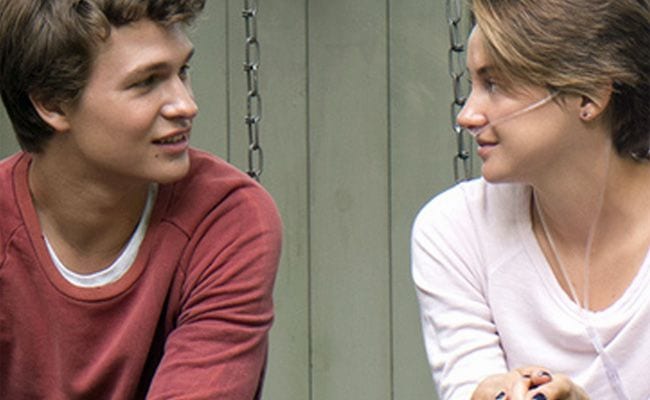
The Fault in Our Stars opens with narration by Hazel (Shailene Woodley), a teenager living with terminal cancer. One way to tell that story is to “sugarcoat it,” she says, “Nothing is too messed up that can’t be fixed with a Peter Gabriel song.” Hazel goes on, “I like that version as much as the next girl does. It’s just not the truth.”
Taken verbatim from John Green’s source novel, a young-adult-and-beyond sensation, this voiceover will seem to fans the perfect opening, maybe the only opening. But a movie that positions itself as “the truth” takes a certain risk — especially as it raises the specter of the beloved Say Anything, where a Peter Gabriel song does fix everything. In the pages of a novel, these words aren’t part of sporadic voiceover narration, but the text itself. That opening salvo, then, is not a rough approximation of Hazel’s point of view, but a clear expression of it. On screen, though, it’s just a movie asserting that it’s going to be more truthful than other movies.
To be fair, The Fault in Our Stars is probably more truthful than a lot of other movies about how we process death, about the experience of being young and in love, and about the stories we tell ourselves to reconcile those diametrically opposed feelings. Hewing closely to the novel’s self-described sincerity, the movie gains further credibility from casting Woodley as Hazel.
Even when she’s not actually starring (as in The Spectacular Now, another YA adaptation by Fault screenwriters Scott Neustadter and Michael H. Weber) or when she’s working with middling material (as in Divergent, a more fantastical YA property), Woodley has an honest openness about her. She both radiates and inspires empathy.
The Fault in Our Stars provides a showcase for exactly that. Hazel’s survival to age 16 has been both miraculous and not enough. She needs oxygen tubes to prop up her failing lungs, and while she may have some more years left, she’s unlikely to live to a proper old age. Her parents (Laura Dern and Sam Trammell) know that at some point, they will be mourning her. They nonetheless insist that she try to keep connections with the outside world, and send her to a support group.
There she meets Gus (Ansel Elgort), who has lost a leg to cancer, now in remission, attending the group to support his buddy Isaac (Nat Wolff), who has lost an eye to cancer and will soon lose another. Hazel and Gus catch each other’s eyes, make small talk after the session, and quickly fall into the kind of thoughtful yet instinctive attraction that may only make sense for the young, or, in Green’s words, “the way you fall asleep, slowly, then all at once.”
Similarly, Hazel and particularly Gus speak with the kind of self-conscious, secret-language wittiness that might become precious in older characters’ mouths and sometimes threatens to do the same here. Much of their dialogue comes straight from Green’s book, where it complements Hazel’s engaging first-person narration. Neustadter and Weber do a respectful and respectable job condensing scenes and pruning characters, as even a less plotty novel like The Fault in Our Stars requires, but they don’t translate the novel to account for it being acted out rather than read, not trusting the actors’ line deliveries or reaction shots.
The screenplay’s caution is paralleled by director Josh Boone’s choices. He approaches the visualization of his film with a strange timidity, as if fearful of fans’ wrath. With Hazel’s first-person accounts necessarily limited, much of the movie becomes an ongoing conversation between Hazel and Gus, which Boone over-cuts into awkward assemblies of shot styles. Over-the-shoulder shots, medium close-ups, and wider shots from arbitrary angles collide with little sense of rhythm, and scenes like Gus and Hazel’s crucial first long talk become testaments to the amount of coverage Boone shot for these scenes rather than any specific ideas about how such scenes might look and what they might convey. Even when he manages to frame Hazel and Gus together (a surprisingly infrequent occurrence), the compositions are startlingly, almost distractingly, unimaginative.
When the camera does linger, it’s usually on Woodley’s face, and her expressiveness as she processes Hazel’s conflicting emotions has heartbreaking eloquence. Elgort, for his part, captures both the sweetness and slight arrogance of Gus’s charisma, and if the other book characters — Isaac, Hazel’s parents, a reclusive writer whose work Hazel shares with Gus — aren’t as distinctive in their on-screen incarnations, they at least serve to keep the movie focused on two people who matter most to each other. The actors and the basic material ensure that The Fault in Our Stars remains, in its movie form, an affecting love story.
What The Fault in Our Stars lacks is the offhand poetry of Green’s book, even as the actors quote it repeatedly. The emotions are warm and earnest, sometimes raw and challenging, but the sterile digital cinematography creates a visual distance that suspends the story in traditional weepie territory. Woodley, Elgort, and the book they love deserve a movie as vibrant — and as truthful — as they are.


![Call for Papers: All Things Reconsidered [MUSIC] May-August 2024](https://www.popmatters.com/wp-content/uploads/2024/04/all-things-reconsidered-call-music-may-2024-720x380.jpg)



